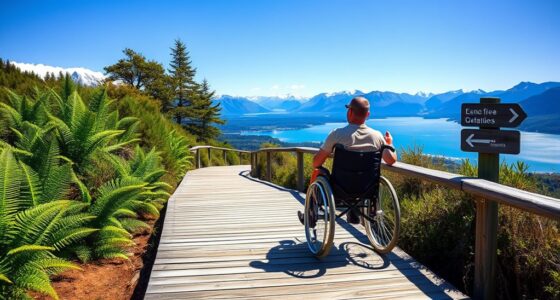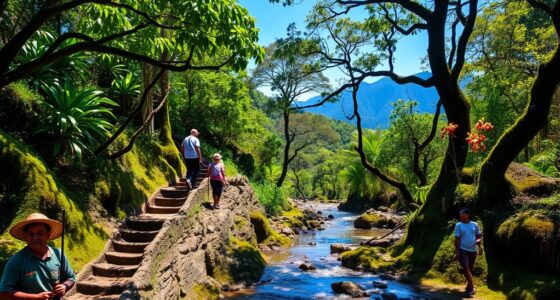Low-impact hiking in Tongariro National Park means you’re respecting the stunning environment while enjoying your adventure. Stay on designated paths to protect wildlife and avoid trail erosion. Keep your distance from animals and never feed them, as natural behaviors are essential for their health. Carry reusable containers and pack out all your trash to keep the park clean. Every choice you make matters when it comes to preserving this beautiful landscape, and there’s more to discover about how you can help.
Key Takeaways
- Stick to designated trails to protect wildlife habitats and prevent trail erosion in Tongariro National Park.
- Hike during off-peak times to minimize trail wear and support ecosystem health.
- Carry reusable containers and dispose of all trash properly to keep the park clean and wildlife safe.
- Educate yourself about local ecosystems to enhance your appreciation and understanding of conservation needs.
- Participate in guided low-impact hikes to learn sustainable practices and support local conservation efforts.

If you’re looking to explore the breathtaking beauty of Tongariro National Park while minimizing your impact on the environment, low-impact hiking is the perfect way to do it. This stunning park is home to diverse ecosystems, rich wildlife, and unique landscapes. By adopting low-impact hiking practices, you can help preserve this natural wonder for future generations.
One of the key benefits of low-impact hiking is its role in wildlife preservation. As you traverse the trails, be mindful of your surroundings. Stick to designated paths to avoid disturbing habitats and nesting areas. This practice not only protects the flora and fauna but also contributes to the overall health of the ecosystem. If you happen to spot wildlife, resist the urge to approach or feed them. Keeping a respectful distance ensures that animals remain undisturbed and can thrive in their natural environment.
Embrace low-impact hiking to protect wildlife and preserve the delicate balance of ecosystems in Tongariro National Park.
Trail erosion is another vital concern when hiking in Tongariro National Park. The park’s trails are often subject to wear and tear from foot traffic, especially in high-traffic areas. By choosing to hike during off-peak times or selecting less popular routes, you can help reduce this strain. When hiking, always maintain a steady pace and avoid shortcuts that can lead to trail widening and further erosion. Remember, even small choices can make a significant difference.
Carrying out your trash is another essential part of low-impact hiking. Make sure to bring reusable containers for snacks and drinks, and stash any waste in your bag until you can dispose of it properly. This simple act helps keep the park clean and minimizes the impact on wildlife that might encounter litter. You’ll find that being conscientious about your waste not only benefits the environment but also enhances your hiking experience.
Lastly, consider educating yourself about the park’s unique environment. Understanding the delicate balance of ecosystems and the threats they face can deepen your appreciation for the landscape around you. Engaging with local conservation efforts or participating in guided low-impact hikes can provide valuable insights. By focusing on hormonal balance and overall wellness, women over 40 can enhance their hiking experience and promote a healthier lifestyle.
As you lace up your hiking boots and set off to explore Tongariro National Park, remember that every step matters. By embracing low-impact hiking practices, you can help preserve this extraordinary place while enjoying all its beauty. Your efforts contribute to the preservation of wildlife and the integrity of the trails, ensuring that the park remains a pristine destination for others to enjoy.
Frequently Asked Questions
What Is the Best Time of Year for Low-Impact Hiking?
The best time of year for low-impact hiking is during the spring and autumn months. You’ll enjoy mild temperatures and less crowded trails, making for a more pleasant experience. Seasonal weather in these months often brings clear skies and vibrant landscapes. Plus, trail accessibility is generally at its peak, allowing you to explore a variety of paths without the challenges posed by winter snow or summer heat. So, plan your hikes accordingly!
Are There Guided Tours Available for Low-Impact Hikes?
Yes, you’ll find plenty of guided tour options for low-impact hikes. These eco-friendly hiking tours are designed to minimize your footprint while exploring beautiful landscapes. Local guides often share their knowledge about the environment and offer tips on sustainable practices. By joining a guided tour, you can enjoy a more immersive experience while ensuring that your hiking adventure respects the natural surroundings. It’s a great way to connect with nature responsibly!
What Wildlife Can I Expect to See While Hiking?
While hiking, you’re likely to spot a variety of bird species like the Kiwi and Takahe, which can be quite an exciting experience. Don’t worry if you don’t see them right away; they often blend into their surroundings. You’ll also encounter stunning native plants, such as the unique Rimu and Kauri trees. Keep your eyes peeled, and you might just catch a glimpse of the vibrant wildlife that calls this area home.
Are There Any Age Restrictions for Low-Impact Hiking?
There aren’t any strict age restrictions for low-impact hiking, making it a great option for families. You’ll find plenty of family-friendly hikes suitable for all ages and skill levels. Just keep in mind your children’s abilities and stamina, and choose trails that match their pace. Always prioritize safety, ensuring younger hikers stay close and hydrated. With the right planning, everyone can enjoy the beauty of nature together!
Is Camping Allowed in Tongariro National Park?
Yes, camping’s allowed in Tongariro National Park, but you need to follow specific camping regulations. You can enjoy stunning views, immerse yourself in nature, and experience the park’s unique landscapes. Make sure to check the designated camping areas and guarantee you’re respecting the park’s accessibility guidelines. Remember to leave no trace, so future visitors can enjoy the beauty just like you do. Embrace the adventure while being responsible!
Conclusion
In summary, low-impact hiking in Tongariro National Park not only lets you explore stunning landscapes but also helps preserve this natural wonder for future generations. Did you know that over 1,000 species of plants thrive in the park? Embracing eco-friendly practices while you hike can make a real difference. So, lace up your boots, tread lightly, and soak in the beauty around you, knowing you’re contributing to the protection of this incredible environment. Happy hiking!









